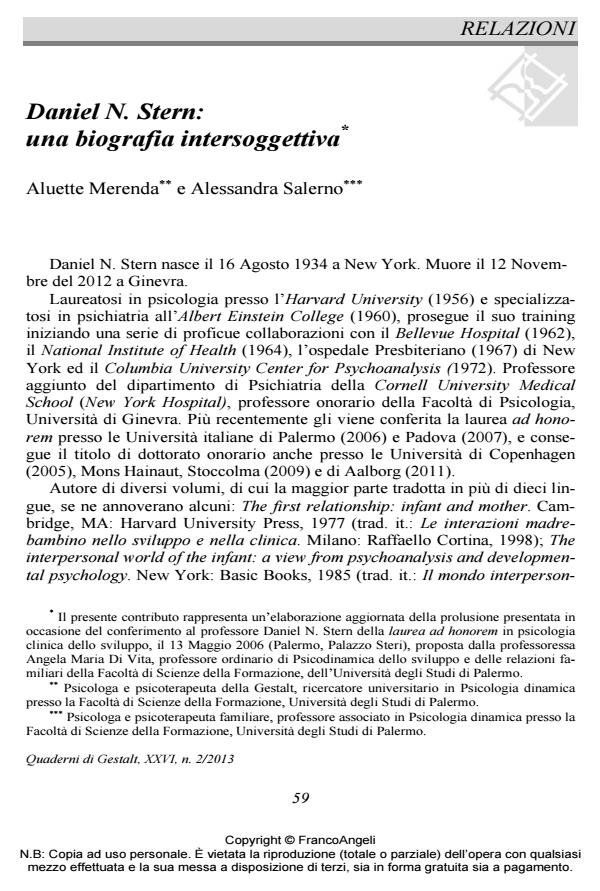Daniel N. Stern: una biografia intersoggettiva
Titolo Rivista QUADERNI DI GESTALT
Autori/Curatori Aluette Merenda, Alessandra Salerno
Anno di pubblicazione 2014 Fascicolo 2013/2
Lingua Italiano Numero pagine 7 P. 59-65 Dimensione file 734 KB
DOI 10.3280/GEST2013-002008
Il DOI è il codice a barre della proprietà intellettuale: per saperne di più
clicca qui
Qui sotto puoi vedere in anteprima la prima pagina di questo articolo.
Se questo articolo ti interessa, lo puoi acquistare (e scaricare in formato pdf) seguendo le facili indicazioni per acquistare il download credit. Acquista Download Credits per scaricare questo Articolo in formato PDF

FrancoAngeli è membro della Publishers International Linking Association, Inc (PILA)associazione indipendente e non profit per facilitare (attraverso i servizi tecnologici implementati da CrossRef.org) l’accesso degli studiosi ai contenuti digitali nelle pubblicazioni professionali e scientifiche
Il presente contributo rappresenta una nota sulla biografia di Daniel Stern ove emerge una prospettiva intersoggettiva che attraversa la sua vita come studioso delle relazioni primarie. In particolare, viene enfatizzato il paradigma del changing di tutte le forme vitali (arte, sviluppo, psicologia e psicoterapia) che lo porta a comparare il contesto dello sviluppo infantile con l’ambito del setting terapeutico psicoanalitico, riattualizzando i medesimi costrutti e schemi relazionali impliciti, individuati nello sviluppo della relazione tra bambino e caregiver.
Parole chiave:Intersoggettività, changing, relazioni primarie, forme vitali, psicoterapia, sviluppo
- Thompson E. (2001). Empathy and consciousness. Journal of Consciousness Studies, 8, 5-7: 1-32.
- Varela F.J. (1996). Neurophenomenology: a methodological remedy to the hard problem. Journal of Consciousness Studies, 3, 4: 330-350.
- Zahavi D. (1996). Edmund Husserl. Fænomenologi og kunst. Den Blå Port, 37: 45-61.
- Braten S. (2009). The intersubjective mirror in infant learning and evolution of speech. Amsterdam/Philadelphia: John Benjamins Publishing Company.
- Clark H.H. (1999). Psycholinguistics. Cambridge, MA: MIT Encyclopedia of the Cognitive Sciences, MIT Press.
- Damasio A. (1999). The feeling of what happens: body and emotion in the making of consciousness. New York: Harcourt.
- Freeman T.C.A. (1999). Path perception and Filehne illusion compared: model and data. Vision Research, 39, 16: 2659-2667. DOI: 10.1016/S0042-6989(98)00293-
- Gallagher S.A. (1997). Problem-based learning: Where did it come from, what does it do, and where is it going? Journal for the Education of the Gifted, 20, 4: 332-362.
- Husserl E. (1960). Cartesian meditations: an introduction to Phenomenology. Nijhoff: The Hague.
- Marbach E. (1996). Understanding the representational mind: a phenomenological perspective. Human Studies, 19, 2: 137-52. DOI: 10.1007/BF0013149
- Sheets-Johnstone M. (1999). The primacy of movement. Amsterdam: John Benjamins.
- Stern D.N. (1977). The first relationship: infant and mother. Cambridge, MA: Harvard University Press (trad. it.: Le interazioni madre-bambino nello sviluppo e nella clinica. Milano: Raffaello Cortina, 1998).
- Stern D.N. (1985). The interpersonal world of the infant: a view from psychoanalysis and developmental psychology. New York: Basic Books (trad. it.: Il mondo interpersonale del bambino. Torino: Bollati Boringhieri, 1987).
- Stern D.N. (1990). Diary of a Baby. New York: Basic Books (trad. it.: Diario di un bambino. Milano: Oscar Mondadori, 1999).
- Stern D.N. (1995). The motherhood constellation: a unifying view of parent-infant psychotherapies. New York: Basic Books (trad. it.: La costellazione materna: il trattamento psicoterapeutico della coppia madre-bambino. Torino: Bollati Boringhieri, 1995).
- Stern D.N. (2003). The present moment in psychotherapy and everyday life. New York: Norton and Odile Jacob (trad. it.: Il momento presente in psicoterapia e nella vita quotidiana. Milano: Raffaello Cortina, 2005).
- The Boston Change Process Study Group (2010). Change in psychotherapy: a unifying paradigm. New York: Norton W. Norton & Company.
Aluette Merenda, Alessandra Salerno, Daniel N. Stern: una biografia intersoggettiva in "QUADERNI DI GESTALT" 2/2013, pp 59-65, DOI: 10.3280/GEST2013-002008